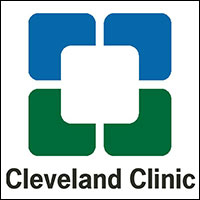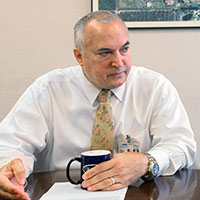 Cleveland Clinic seen developing major center here
Cleveland Clinic seen developing major center here
STORY BY MILTON R. BENJAMIN
Two months after retiring as CEO of Indian River Medical Center, Jeff Susi last week spoke out publicly for the first time about the decision by the IRMC board and the Hospital District to partner with Cleveland Clinic, terming the prospect of a Cleveland takeover “the best thing that could happen” for the Vero Beach community.
“Cleveland Clinic really wants to develop a major medical center here. I think they’ll just take it to a new level,” Susi said in a wide-ranging interview with Vero Beach 32963. (Excerpts from the interview on other subjects, below.)
While Susi termed all four of the health systems that sought to take over IRMC potentially “good partners,” he said the difference “is that for some of them, we could have been a feeder to another hospital nearby.” Two of the finalists have a huge presence in Orlando, and HCA, the nation’s largest health system, owns Lawnwood in neighboring Fort Pierce.
“I think that Cleveland Clinic is going to expand our footprint, draw from a broader area and grow the medical staff, grow the employment base,” Susi said.
“When I look at IRMC and I hear people talking about, you know, who's willing to pay how much for the medical center here, or how much a (for-profit system) would pay in taxes – $2.5 million, I think – the more important impact is the jobs that are created.”
Susi said during his 19 years as CEO of IRMC, the hospital staff grew to 1,700 and the payroll to more than “$150 million last year, and I think Cleveland Clinic will take that to $200 million or more in the next three years.
“That is a tremendous impact on the local economy. They’ll end up growing the medical staff. Those people live here, they shop here, they buy cars here, they bank here, they buy real estate. All those things are going to look very promising with a Cleveland Clinic.
“The value of this transaction is what it does for the economy and what it does for patient care – not the check somebody's going to write. That's a one-time thing. It's this ongoing impact of a major medical center.”
Susi said that in his meetings with the four finalists, he told all of them that the IRMC Health and Wellness Center “is full – it needs to be expanded – and we need an ambulatory surgery center.
“Those are two significant projects that I would expect to come along very quickly because they’ll be recruiting more people to the community. They’re going to need places for those physicians.
“And I think there’s a lot of places around the hospital, medical buildings and whatever, that will benefit from this, because when you start to attract more physicians and more specialties, you’re going to attract more patients and there’s going to be the spin-off to all the physicians that practice here, private as well as (hospital) employed,” he said.
Susi was also optimistic that the arrival of Cleveland Clinic would finally address one major thing that did not happen on his watch – bringing graduate medical education to IRMC.
“We’ve had two task forces that at different times have recommended moving forward with residency programs in medicine and surgery and emergency medicine, and we just did not have the support at the time given healthcare reform and the nervousness about what does this mean going forward,” Susi said.
“But I think Cleveland Clinic can take that, and move that to a whole new level.”
Retired IRMC CEO Jeff Susi in his own words
Excerpts from retired IRMC CEO Jeff Susi’s
interview with Vero Beach 32963.
 On hospital growth during his tenure:
On hospital growth during his tenure:
I look at the medical center today and what it was 19 years ago and it’s night and day. I came in December of 1998, and in the spring of 1999, the board approved a strategic plan that would transform us into a medical center. And if you go back and read that original plan, it said that we would create a heart center affiliated with a Center of Excellence, a cancer center, a medical office building with an emphasis on wellness, and outreach north, south and west. It took 17 years, but all of that has taken place.
On key figures at IRMC:
Through my two decades, there were three physicians – incredible leaders – people that I admire, respect and learned a lot from. Dr. Felix Demartini was retired, but he had been a Columbia faculty member and retired from the position of president and CEO of Presbyterian Medical Center in New York. And when I was talking to board members about a heart program, Felix said, ‘I'll support you if we don't reinvent the wheel and we affiliate with somebody that has a national reputation.’ I said, ‘Well, I think that's important.’ Then Dr. Dick Weil, who became chairman later, was actually a resident under Dr. Demartini at Columbia. Dr. Weil was the second great physician leader that we had on the board and he was all about quality, and served as a great chairman, very strong, chaired the patient care committee. And then last but not least, Dr. Bill Kelley – who served on the board until just about a year and a half ago. Bill Kelley was a rheumatologist at Duke, was at the University of Michigan as chief of medicine, and then he went to Philadelphia as CEO of the Penn health system. He came on the board and was outstanding in terms of, again, focusing the discussions on quality and patients first. And Clark Beckett doesn't get enough credit. He’s a vascular surgeon, and I asked Clark to chair the work group to develop the work plan for open heart surgery. And he stepped into that.
On the heart program:
In my opinion, the foundation of a medical center is doing complex things. That meant we had to have a heart program. And when you have a good heart program, you raise the level of everything you do – critical care, respiratory, cardiology, laboratory, imaging, all that stuff gets better. The approval came in 2005 and then almost the same time, the affiliation with Duke and then Dr. Cary Stowe came here, and we did our first heart surgery in 2006. But beyond that, you know, Dr. Stowe was able to attract Dr. Malias, Dr. Lindenthal for anesthesia, Drs. Midwall and Kieval for interventional cardiology, and then most recently, Dr. Faulknier for electrophysiology. So talent brings talent and I credit Dr. Stowe a lot in developing our program. It may have been my dream, but other people make those dreams come true.
On the affiliation with Duke:
I thought originally we would affiliate with somebody in Florida, but we had some conversations and they were saying, ‘Well, you know, we can affiliate but you don't have to do everything. You can do the emergencies, but you can send your valves to us, you can send this.’ And I realized you can't set out trying to be a second-best program. You really have to set out to be the best you can be. The current affiliation agreement runs through December of 2019. I think that it will sunset and you know, if we had affiliated with a number of other partners that didn't have the expertise that Cleveland Clinic has, it could've gone the other way. It could've renewed and it might even have expanded. But given Cleveland Clinic, who everyone knows what a great heart program they have, I think that the need for that affiliation went away. I also went on Cleveland Clinic's website a while ago and I was impressed with what they do on cancer care in Cleveland. It's amazing what they're doing. So, you know, our cancer program is in its infancy, Jim Grichnik came in January of 2016. So really this is the beginning of his third year, but that has equal potential to grow and be a game changer.
On the hospital’s finances:
I think the record is unclear on how financially strong the hospital is. During my tenure, you know, one reporter for another paper wanted to take one line-item out – it really is a subtotal, you know, the P&L (profit and loss) from operations – and he's got a figure $40 something million (that the hospital has lost) and that's telling half the picture. We had interest expense on bonds that was above the line that entered into that, but interest income from investments or a market improvement from investments was below the line. He ignored half the picture. We generated positive cash flow in those two decades of well over $100 million. We were investing all the time. Whatever came from cash flow went back into the operations. So there was $100 plus million from the hospital and $100 million from the foundation, $200 million of improvement. And during my tenure, the net assets, which is like net worth on the books, went from about $100 million to over $180 million. So that’s not a financially losing proposition. We created great wealth on the balance sheets.
On criticism over the years:
I think that I did well with having a thick skin. I didn't always do what was popular but I always did what I thought was right for the community. I don’t know that I would do anything differently. I paid a personal price in the community with reputation. But I think at the end of the day, maybe the vindication is to have a Cleveland Clinic aspiring to come in here and take us to the next step. That’s a huge satisfaction for me.








